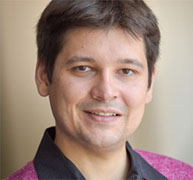Robert Haslhofer et Egor Shelukin sont les lauréats du Prix André-Aisenstadt 2021
Le prix André-Aisenstadt reconnaît cette année le talent de Robert Haslhofer (Université de Toronto) et Egor Shelukin (Université de Montréal). Plusieurs brillants mathématiciens étaient en lice pour le prix André-Aisenstadt cette année. Encore une fois, le Comité scientifique international du CRM a été particulièrement impressionné par les réalisations de ces candidats et a ainsi décidé que deux prix devaient être décernés. Situation rare, ceci est une expression de grande qualité de leurs travaux.
 Robert Haslhofer (University of Toronto)
Robert Haslhofer (University of Toronto)
Mean curvature flow through neck-singularities
Résumé : A family of surfaces moves by mean curvature flow if the velocity at each point is given by the mean curvature vector. Mean curvature flow first arose as a model of evolving interfaces and has been extensively studied over the last 40 years.
In this talk, I will give an introduction and overview for a general mathematical audience. To gain some intuition we will first consider the one-dimensional case of evolving curves. We will then discuss Huisken’s classical result that the flow of convex surfaces always converges to a round point. On the other hand, if the initial surface is not convex we will see that the flow typically encounters singularities. Getting a hold of these singularities is crucial for most striking applications in geometry, topology and physics. Specifically, singularities can be either of neck-type or conical-type. We will discuss examples from the 90s, which show, both experimentally and theoretically, that flow through conical singularities is utterly non-unique.
In the last part of the talk, I will report on recent work with Kyeongsu Choi, Or Hershkovits and Brian White, where we proved that mean curvature flow through neck-singularities is unique. The key for this is a classification result for ancient asymptotically cylindrical flows that describes all possible blowup limits near a neck-singularity. In particular, this confirms the mean-convex neighborhood conjecture. Assuming Ilmanen’s multiplicity-one conjecture, we conclude that for embedded two-spheres mean curvature flow through singularities is well-posed.
Biographie : Robert Haslhofer est professeur adjoint au Département de mathématiques de l’Université de Toronto depuis 2015. Il a obtenu son doctorat en 2012 à l’École polytechnique fédérale de Zurich. Haslhofer était alors instructeur au Courant Institute of Mathematical Sciences. Ses intérêts de recherche sont centrés sur l’analyse géométrique, la géométrie différentielle, les équations aux dérivées partielles, le calcul des variations, l’analyse stochastique, la relativité générale. Ses recherches sont actuellement financées par une subvention à la découverte du CRSNG et une bourse de recherche Sloan.
 Egor Shelukin (Université de Montréal)
Egor Shelukin (Université de Montréal)
Symmetry, barcodes, and Hamiltonian dynamics
Résumé : In the early 60s Arnol’d has conjectured that Hamiltonian diffeomorphisms, the motions of classical mechanics, often possess more fixed points than required by classical topological considerations. In the late 80s and early 90s Floer has developed a powerful theory to approach this conjecture, considering fixed points as critical points of a certain functional. Recently, in joint work with L. Polterovich, we observed that Floer theory filtered by the values of this functional fits into the framework of persistence modules and their barcodes, originating in data sciences. I will review these developments and their applications, which arise from a natural time-symmetry of Hamiltonians. This includes new constraints on one-parameter subgroups of Hamiltonian diffeomorphisms, as well as my recent solution of the Hofer-Zehnder periodic points conjecture. The latter combines barcodes with equivariant cohomological operations in Floer theory recently introduced by Seidel to form a new method with further consequences.
Biographie : Egor Shelukhin est un mathématicien qui travaille actuellement comme professeur adjoint au Département de mathématiques et de statistique de l’Université de Montréal. Il a obtenu son doctorat en 2012 à l’Université de Tel Aviv sous la direction de Leonid Polterovich . Shelukhin a ensuite été chercheur postdoctoral CRM-ISM au Centre de recherches mathématiques (CRM) de 2012 à 2014. Il a passé le semestre de printemps 2014 à l’Université hébraîque de Jérusalem et l’été 2015 à l’Université Lyon 1 Claude Bernard . Shelukhin a été boursier à l’Institut Mittag Leffler en septembre 2015. De 2015 à 2017, il a été membre de l’école de mathématiques de l’Institute for Advances Study, Princeton. Son travail est centré sur la topologie symplectique, la topologie des contact et l’analyse géométrique.



 Egor Shelukin (Université de Montréal)
Egor Shelukin (Université de Montréal)
